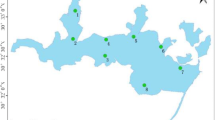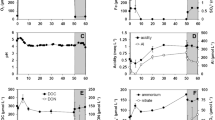Abstract
Nitrate (NO3 −) reduction processes are important for depleting the NO3 − load from agricultural source areas before the discharge water reaches surface waters or groundwater aquifers. In this study, we experimentally demonstrate the co-occurrence of microbial iron sulfide oxidation by NO3 − (MISON) and other NO3 −-depleting processes in a range of contrasting sediment types: sandy groundwater aquifer, non-managed minerotrophic freshwater peat and two brackish muddy sediments. Approximately 1/3 of the net NO3 − reduction was caused by MISON in three of the four environments despite the presence of organic carbon in the sediment. An apparent salinity limitation to MISON was observed in the most brackish environment. Addition of high surface area synthetically precipitated iron sulfide (FeS x ) to the aquifer sediment with the lowest natural FeS x reactivity increased both the relative fraction of NO3 − reduction linked to MISON from approximately 30–100 % and the absolute rates by a factor of 17, showing that the potential for MISON-related NO3 − reduction is environmentally significant and rate limited by the availability of reactive FeS x .








Similar content being viewed by others
References
Bosch J, Meckenstock RU (2012) Rates and potential mechanism of anaerobic nitrate-dependent microbial pyrite oxidation. Biochem Soc Trans 40:1280–1283. doi:10.1042/BST20120102
Bottrell SH, Parkes RJ, Cragg BA, Raiswell R (2000) Isotopic evidence for anoxic pyrite oxidation and stimulation of bacterial sulphate reduction in marine sediments. J Geol Soc London 157:711–714
Brunet R, Garcia-Gil LJ (1996) Sulfide-induced dissimilatory nitrate reduction to ammonia in anaerobic freshwater sediments. FEMS Microbiol Ecol 21:131–138. doi:10.1016/0168-6496(96)00051-7
Burgin A, Hamilton S, Jones S, Lennon J (2012) Denitrification by sulfur-oxidizing bacteria in a eutrophic lake. Aquat Microb Ecol 66:283–293. doi:10.3354/ame01574
Canfield DE, Thamdrup B, Hansen JW (1993) The anaerobic degradation of organic matter in Danish coastal sediments: iron reduction, manganese reduction, and sulfate reduction. Geochim Cosmochim Acta 57:3867–3883
Devlin J, Eedy R, Butler B (2000) The effects of electron donor and granular iron on nitrate transformation rates in sediments from a municipal water supply aquifer. J Contam Hydrol 46:81–97. doi:10.1016/S0169-7722(00)00126-1
Dincer A, Kargi F (1999) Salt inhibition of nitrification and denitrification in saline wastewater. Environ Technol 20:1147–1153
Elberling B, Balić-Žunić T, Edsberg A (2003) Spatial variations and controls of acid mine drainage generation. Environ Geol 43:806–813. doi:10.1007/s00254-002-0695-8
Elberling B, Askaer L, Jørgensen CJ et al (2011) Linking soil O2, CO2, and CH4 concentrations in a Wetland soil: implications for CO2 and CH4 fluxes. Environ Sci Technol 45:3393–3399. doi:10.1021/es103540k
Flindt MR, Kamp-Nielsen L, Marques JC et al (1997) Description of the three shallow estuaries : mondego River (Portugal), Roskilde Fjord (Denmark) and the Lagoon of Venice (Italy). Ecol Modell 102:17–31
Folk R (2005) Nannobacteria and the formation of framboidal pyrite: textural evidence. J Earth Syst Sci 114:369–374
Frind E, Duynisveld WH, Strebel O, Boettcher J (1990) Modelling of multicomponent transport with microbial transformation in groundwater: the Fuhrberg Case. Water Resour Res 26:1707–1719
Gramp JP, Bigham JM, Jones FS, Tuovinen OH (2010) Formation of Fe-sulfides in cultures of sulfate-reducing bacteria. J Hazard Mater 175:1062–1067. doi:10.1016/j.jhazmat.2009.10.119
Haaijer SCM, Lamers LPM, Smolders AJP, Jetten MSM, den Camp HJMO (2007) Iron sulfide and pyrite as potential electron donors for microbial nitrate reduction in freshwater wetlands. Geomicrobiol J 24:391–401. doi:10.1080/01490450701436489
Hayakawa A, Hatakeyama M, Asano R, Ishikawa Y, Hidaka S (2013) Nitrate reduction coupled with pyrite oxidation in the surface sediments of a sulfide-rich ecosystem. J Geophys Res Biogeosci 118:639–649. doi:10.1002/jgrg.20060
Huerta-Diaz M, Morse J (1992) Pyritization of trace metals in anoxic marine sediments. Geochim Cosmochim Acta 56:2681–2702
Jacobsen OS, Larsen HV, Andreasen L (1990) Nitrate recuction by pyrite and lignite in sandy aquifer. In: Nitrogen and phosphorus in soil and air—B-abstracts of the Danish Research Programme on Nitrogen Phosphorus and Organic Matter (NPo). 151–166
Jørgensen CJ, Jacobsen OS, Elberling B, Aamand J (2009) Microbial oxidation of pyrite coupled to nitrate reduction in anoxic groundwater sediment. Environ Sci Technol 43:4851–4857
Jørgensen CJ, Struwe S, Elberling B (2012) Temporal trends in N2O flux dynamics in a Danish wetland - effects of plant-mediated gas transport of N2O and O2 following changes in water level and soil mineral-N availability. Glob Chang Biol 18:210–222. doi:10.1111/j.1365-2486.2011.02485.x
Kana TM, Sullivan MB, Cornwall JC, Groszkowski KM (1998) Denitrification in estuarine sediments determined by membrane inlet mass spectrometry. Limnol Oceanogr 43:334–339
Korom SF, Schlag AJ, Schuh WM, Kammer Schlag A (2005) In situ mesocosms: denitrification in the Elk Valley aquifer. Ground Water Monit Remediat 25:79–89. doi:10.1111/j.1745-6592.2005.0003.x
Laverman AM, Van Cappellen P, van Rotterdam-Los D et al (2006) Potential rates and pathways of microbial nitrate reduction in coastal sediments. FEMS Microbiol Ecol 58:179–192. doi:10.1111/j.1574-6941.2006.00155.x
Leppäranta M, Myrberg K (2008) Physical oceanography of the Baltic Sea. Springer, Berlin
Magalhães CM, Joye SB, Moreira RM et al (2005) Effect of salinity and inorganic nitrogen concentrations on nitrification and denitrification rates in intertidal sediments and rocky biofilms of the Douro River estuary, Portugal. Water Res 39:1783–1794. doi:10.1016/j.watres.2005.03.008
McKibben M, Barnes H (1986) Oxidation of pyrite in low temperature acidic solutions: rate laws and surface textures. Geochim Cosmochim Acta 50:1509–1520
Miotliński K (2008) Coupled reactive transport modeling of redox processes in a nitrate-polluted sandy aquifer. Aquat Geochem 14:117–131. doi:10.1007/s10498-008-9028-1
Pauwels H, Ayraud-Vergnaud V, Aquilina L, Molénat J (2010) The fate of nitrogen and sulfur in hard-rock aquifers as shown by sulfate-isotope tracing. Appl Geochem 25:105–115. doi:10.1016/j.apgeochem.2009.11.001
Pons L, van Breemen N, Driessen P (1982) Physiography of coastal sediments and development of potential soil acidity. In: Acid Sulphate Weathering, Part I. Soil Science Society of America, Madison, USA, pp 1–18
Postma D (1982) Pyrite and siderite formation in brackish and freshwater swamp sediments. Am J Sci 282:1151–1183
Postma D, Boesen C, Kristiansen H, Larsen F (1991) Nitrate reduction in an unconfined sandy aquifer: water chemistry, reduction processes, and geochemical modeling. Water Resour Res 27:2027–2045
Rasmussen ES, Vangkilde-Pedersen T, Scharling P (2007) Prediction of reservoir sand in miocene deltaic deposits in Denmark based on high-resolution seismic data. Geol Surv Den Greenl Bull 13:17–20
Rivett MO, Buss SR, Morgan P et al (2008) Nitrate attenuation in groundwater: a review of biogeochemical controlling processes. Water Res 42:4215–4232
Salmon SU, Malmström ME (2006) Quantification of mineral dissolution rates and applicability of rate laws: laboratory studies of mill tailings. Appl Geochem 21:269–288. doi:10.1016/j.apgeochem.2005.09.014
Schippers A, Jørgensen BB (2001) Oxidation of pyrite and iron sulfide by manganese dioxide in marine sediments. Geochim Cosmochim Acta 65:915–922
Schippers A, Jørgensen BB (2002) Biogeochemistry of pyrite and iron sulfide oxidation in marine sediments. Geochim Cosmochim Acta 66:85–92
Smith R, Duff J (1988) Denitrification in a sand and gravel aquifer. Appl Environ Microbiol 54:1071–1078
Tiedje JM, Sexstone AJ, Myrold DD, Robinson JA (1982) Denitrification: ecological niches, competition and survival. Antonie Van Leeuwenhoek 48:569–583
Torrentó C, Cama J, Urmeneta J et al (2010) Denitrification of groundwater with pyrite and Thiobacillus denitrificans. Chem Geol 278:80–91. doi:10.1016/j.chemgeo.2010.09.003
Ucisik AS, Henze M (2004) Biological denitrification of fertiliser wastewater at high chloride concentration. Watere SA 30:191–195
Acknowledgments
This study was funded by a grant from Geocenter Denmark (“Geocenterbevilling MOPAG-project”, Microbiol. GEUS: 05061 (PhD)) and received additional funding from the project “Nitrous oxide dynamics: The missing links between controls on subsurface N2O production/consumption and net atmospheric emissions” financed by the Danish Natural Science Research Council and the Department of Geoscience and Natural Resource Management, University of Copenhagen, Denmark.
Author information
Authors and Affiliations
Corresponding author
Rights and permissions
About this article
Cite this article
Vaclavkova, S., Jørgensen, C.J., Jacobsen, O.S. et al. The Importance of Microbial Iron Sulfide Oxidation for Nitrate Depletion in Anoxic Danish Sediments. Aquat Geochem 20, 419–435 (2014). https://doi.org/10.1007/s10498-014-9227-x
Received:
Accepted:
Published:
Issue Date:
DOI: https://doi.org/10.1007/s10498-014-9227-x




